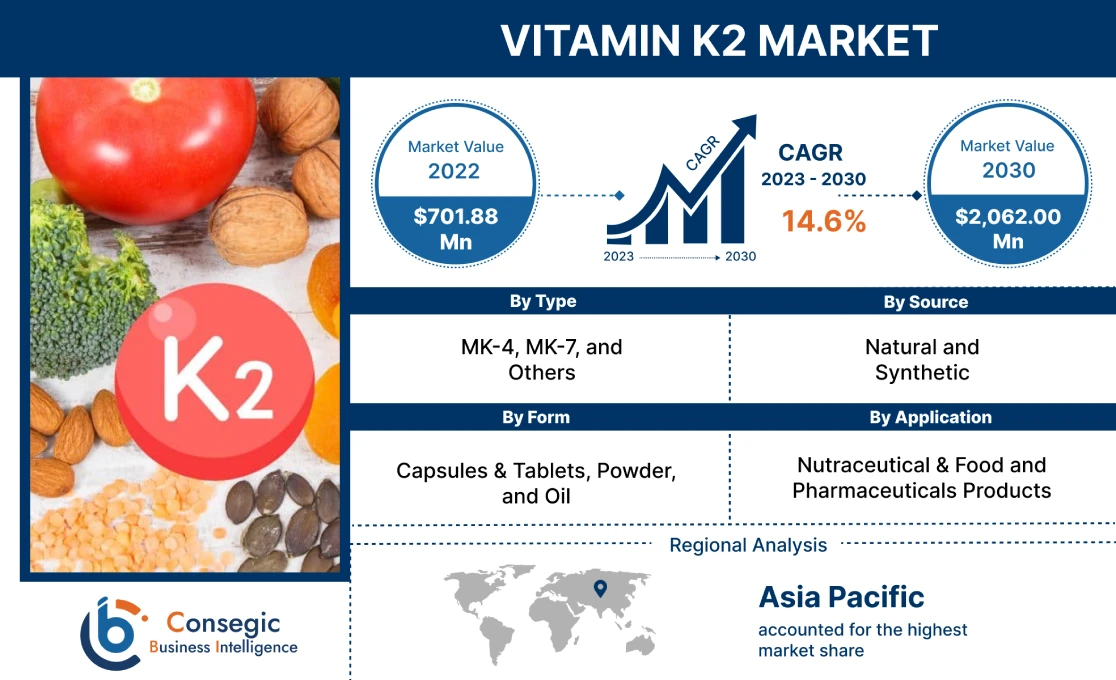Vitamin K2 Market Size :
Consegic Business Intelligence analyzes that the Vitamin K2 market size is growing with a CAGR of 14.6% during the forecast period (2023-2030), and the market is projected to be valued at $2,062.00 Million by 2030 from $701.88 Million in 2022.
Vitamin K2 Market Scope & Overview:
Vitamin K2 is a type of fat-soluble vitamin that helps maintain a strong heart and bones. It contributes to skin health and bone metabolism, promotes proper brain function, and prevents heart-related diseases. It belongs to the class of vitamin K with the chemical formula C41H56O2. This vitamin is synthesized by bacteria in the intestine and is commonly termed menaquinone. Vitamin K2 is superior to vitamin K1 for heart health as it circulates in the body longer than K1 and has better bioavailability. MK-4, and MK-7 both are forms of vitamin k2 derived from different sources, while mk7 is derived from bacterial fermentation and mk4 is derived from animal sources such as dairy products.
Vitamin K2 Market Insights :
Vitamin K2 Market Dynamics - (DRO) :
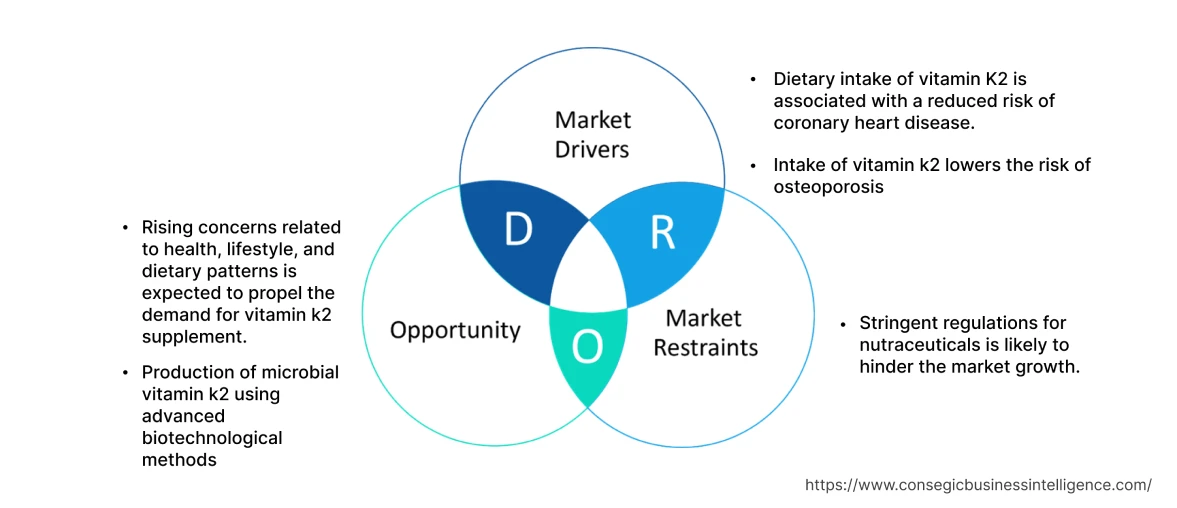
Key Drivers :
The increasing intake of vitamin K2 to reduce the risk associated with coronary heart disease.
In the heart arteries calcium buildup is a high-risk factor. Thus, the consumption of vitamin k2 in the treatment of heart diseases prevents calcium deposition in the arteries. The intake of vitamin k2 reduces arterial stiffness and slows the progression of vascular. For instance, according to the article published in the National Library of Medicine, a study was carried out in which scientists looked at the vitamin K1 and K2 intake of 4,807 Dutch population. The study result showcased that vitamin k2 intake of about 25 μg/day reduced the risk of coronary heart disease by 41%. Thus, the growing consumption of vitamin K2 to prevent the risk of coronary heart disease is boosting the demand of the market.
Intake of vitamin k2 lowers the risk of osteoporosis
Osteoporosis is a bone disease that develops when bone mineral density and bone mass decrease which leads to reduced bone strength, which often results in bone fractures, especially among older women. The consumption of vitamin K2 plays a crucial role in the treatment and prevention of osteoporosis. In the osteoporosis vitamin K2 helps in two ways, it activates the osteocalcin and keeps the calcium out of our blood vessels. For instance, according to the statistics of the International Osteoporosis Foundation, in 2022, osteoporosis causes more than 8.9 million fractures annually, resulting in an osteoporotic fracture every 3 seconds. Thus, the increasing incidence of osteoporosis is driving the growth of the vitamin k2 market.
Key Restraints :
Adverse side effects associated with K2 are restraining the market growth
Vitamin K2 has few side effects including, bloody diarrhea, nausea, upset stomach, severe stomach pain, or vomiting. Additionally, the less serious side effects associated with the consumption of vitamin K2, include constipation or diarrhea, and loss of appetite. Thus, the few side effects associated with vitamin K2 are a major concern for patients and healthcare providers and can limit adoption, particularly in elderly patients, for this reason, adverse side effects associated with K2 is hampering the demand of the market.
Future Opportunities :
Rising concerns related to health, lifestyle, and dietary patterns is expected to propel the demand for vitamin k2 supplement.
Changing dietary patterns, and hectic lifestyles, among other factors are leading to diseases such as autoimmune, osteomalacia, osteoporosis, and rickets. The intake of vitamin k2 helps in preventing the above-mentioned types of diseases. Vitamin K2 contributes to significant protection against osteoporosis, and poor bone development, and helps to prevent the risk of cardiovascular disease.
Additionally, vitamin k2 is involved in the development and survival of brain cells which are expected to prevent autoimmune diseases. Hence, the rising awareness about health and wellness is expected to boost the demand for vitamin K2 to ensure superior health benefits, for this reason, rising concerns related to health, lifestyle, and dietary patterns are expected to propel the demand for vitamin k2 supplements in the forecast year.
Commercialization of organic-grade vitamin K2
The major players in the vitamin K2 market substantially invest in the development of bio-grade vitamin K-12, which is utilized for the prevention of heart-related diseases, and other similar applications. Multiple studies prove that organic-grade-based vitamins have more nutrients. For instance, in October 2022, Kappa Bioscience AS, a leading manufacturer of vitamin K2 launched the 1st bio grade vitamin K2-MK7 named V2Vital MCT in the United States market. Thus, the development and launch of new products related to bio-grade vitamin K2 will create a potential opportunity for the expansion of the global vitamin K2 market during the forecast period.
Vitamin K2 Market Report Insights :
| Report Attributes | Report Details |
| Study Timeline | 2017-2030 |
| Market Size in 2030 (USD Million) | USD 2,062.00 Million |
| CAGR (2023-2030) | 14.6% |
| By Type | MK-4, MK-7, and Others |
| By Source | Natural and Synthetic |
| By Form | Capsules & Tablets, Powder, and Oil |
| By Application | Nutraceutical & Food and Pharmaceuticals Products |
| By Region | North America, Europe, Asia-Pacific, Latin America, and Middle East & Africa |
| Key Players | Anderson Global Group, LLC, BASF SE, Kappa Bioscience (Balchem Corporation), Vox Nutrition, Lesaffre , Purayati, Viridis BioPharma, Lexicare Pharma Pvt. Ltd., AdvaCare Pharma, and Glanbia plc |
Vitamin K2 Market Segmental Analysis :
By Type :
The type segment is categorized into MK-4, MK-7, and others. In 2022, MK-4 segment accounted for the highest market share of 58.50% in the overall vitamin k2 market as MK4 stops and reverses bone loss, grows stronger bones, and reduces bone fractures by 80%. Further, this vitamin promotes healthy platelet, blood production, and connective tissue (collagen) production, thereby promoting healthy life. Hence, the aforementioned factors are driving the segment growth.
However, MK-7 is expected to be the fastest-growing segment in the market during the forecast period owing to the health-beneficial effects of the vitamin to treat and prevent osteoporosis, cancer, Alzheimer's disease, diabetes, and peripheral neuropathy. Moreover, it increases bone mineral density and promotes bone quality and strength.
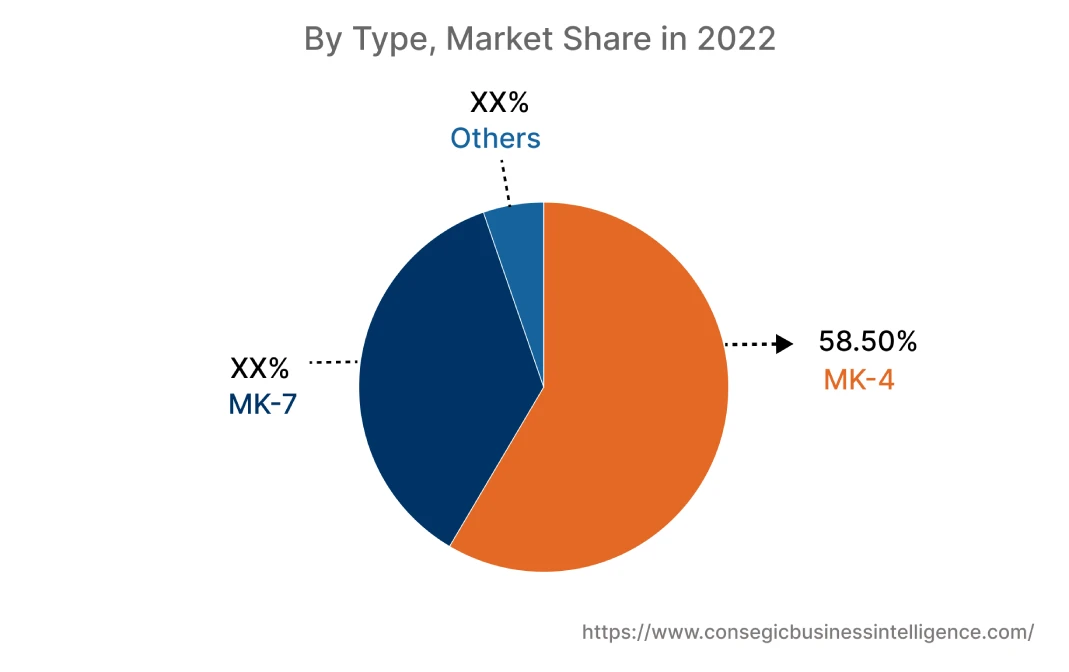
By Source :
The source segment is classified into natural and synthetic. In 2022, the natural source segment accounted for the largest market share and is also expected to grow at the fastest CAGR over the forecast period. This is due to the increasing consumption of dietary and fermented food. Natural vitamin K2 is mainly present in fermented food such as cheese and natto (fermented soybeans). Hence, the increasing growth of dietary supplements is proliferating segment growth.
By Form :
The form segment is categorized into capsules & tablets, powder, and oil. In 2022, the capsules & tablets segment accounted for the highest market share in the vitamin k2 market. Capsules & tablet-based forms of vitamin K2 are widely commercialized in the market. Capsules & tablets of vitamin K2 keep the oral microbiome in balance, prevent cavities, and support remineralization. As a result, the capsules & tablets of vitamin K2 are primarily utilized to treat dental health. For instance, the oral care segment is expected to reach USD 51.45 billion in 2023 and is expected to grow annually by 3.46% by 2027. Hence, the growing need for oral care is driving the demand for the vitamin k2 market.
However, oil form is expected to be the fastest growing segment during the forecast period as the consumption of oil-based vitamin k2 maintains cardiovascular health and healthy blood sugar balance. Vitamin K2 oil has collagen-promoting and wound-healing capabilities which help promote a smoother, and more youthful glow. Further, the oil also has anti-inflammatory and antioxidant properties, which counteract both inflammation and free radicals, thereby preventing skin aging and hyperpigmentation. Hence, the aforementioned factors are expected to proliferate segment growth.
By Application :
The application segment is divided into nutraceutical & food and pharmaceutical products. In 2022, the nutraceutical & food segment accounted for the highest market share in the vitamin k2 market owing to the rising cases of vitamin deficiency disorders which is the major factor increasing the demand for nutraceuticals containing vitamins.
Additionally, Vitamin K Deficiency Bleeding (VKDB) is a condition where newborns bleed uncontrollably due to less vitamin K2 in their bodies. For instance, according to the Centers for Disease Control and Prevention (CDC), early and classical VKDB is more prevalent, occurring in newborn babies. Hence, the growing prevalence of vitamin K deficiency bleeding is driving the demand for nutraceutical products containing vitamin k2.
However, the pharmaceutical product segment is expected to grow at the fastest CAGR during the forecast period owing to the increase of vitamin k2 to treat cancer, osteoporosis, and steroid-induced bone loss due to its hemostatic, anti-osteoporotic, and antioxidant properties.
By Region :
The regional segment includes North America, Europe, Asia Pacific, Middle East and Africa, and Latin America.
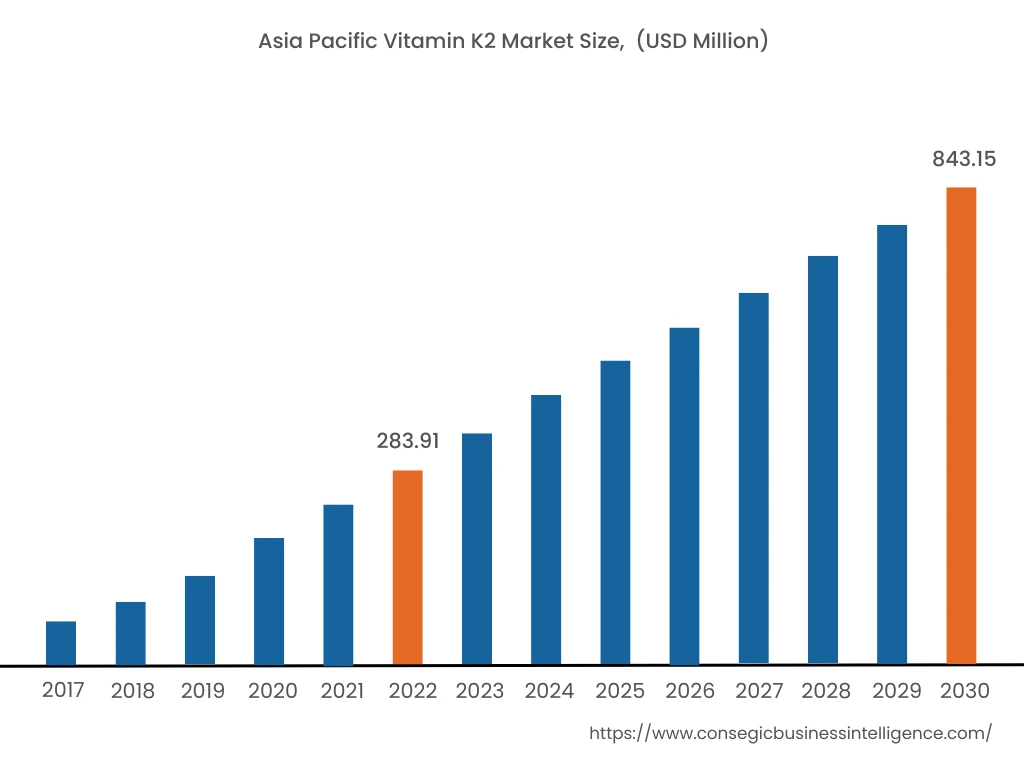
In 2022, Asia Pacific accounted for the highest market share of 40.45% and was valued at USD 283.91 million, and is expected to reach USD 843.15 million in 2030. In Asia Pacific, China accounted for the highest market share of 40.75% during the base year 2022. This is due driven by the increasing incidence of osteoporosis cases particularly in countries such as India and China. Osteoporosis is a serious and growing healthcare problem in India, resulting in fragility fractures. For instance, according to the International Journal of Research in Orthopaedics, the overall prevalence of osteopenia and osteoporosis was 49.9% and 18.3% respectively in India. Thus, the increasing number of cases of osteoporosis is driving the market growth in the region. Moreover, North America is expected to grow at the fastest CAGR of 16.2% over the forecast period. This is due to the growing adoption of vitamin k2 for the proper absorption of calcium.
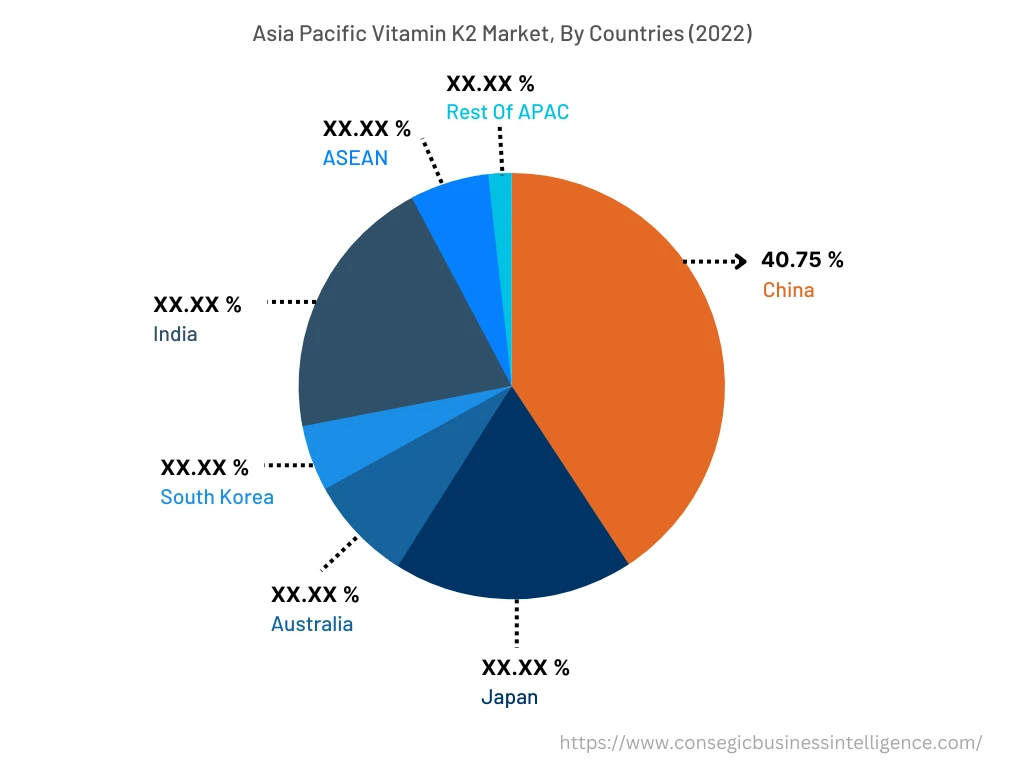
Top Key Players & Market Share Insights:
The vitamin k2 market is highly competitive, with several large players and numerous small and medium-sized enterprises. These companies have strong research and development capabilities and a strong presence in the market through their extensive product portfolios and distribution networks. The market is characterized by intense competition, with companies focusing on expanding their product offerings and increasing their market share through mergers, acquisitions, and partnerships. The key players in the market include -
- Anderson Global Group, LLC
- BASF SE
- Kappa Bioscience (Balchem Corporation)
- Vox Nutrition
- Lesaffre
- Purayati
Recent Industry Developments :
- In June 2022, Balchem Corporation signs a definitive agreement to acquire Kappa Bioscience for approximately USD 340 million to develop superior quality health solutions around vitamin K2 to improve the quality of life.
- In October 2021, Gnosis by Lesaffre introduced a new vitamin K2 ingredient called Matrix K2 at SupplySide West. The new ingredient features the award-winning Matrix technology of the company that protects particles of MK-7 without additives, coating, and additional ingredients.
Key Questions Answered in the Report
What was the market size of the vitamin k2 market in 2022? +
In 2022, the market size of vitamin k2 was USD 701.88 million.
What will be the potential market valuation for the vitamin k2 market by 2030? +
In 2030, the market size of vitamin k2 is expected to reach USD 2,062.00 Million.
What are the key factors driving the growth of the vitamin k2 market? +
Dietary intake of vitamin k2 is associated with a reduced risk of coronary heart disease and lowering the risk of osteoporosis which are the key factors driving the growth of the vitamin k2 market.
What is the dominating segment in the vitamin k2 market by type? +
In 2022, the MK-4 accounted for the highest market share of 58.50% in the overall vitamin k2 market.
Based on current market trends and future predictions, which geographical region will have the fastest impact on the vitamin k2 market's growth in the coming years? +
North America is expected to be the fastest-growing region in the market during the forecast period.
